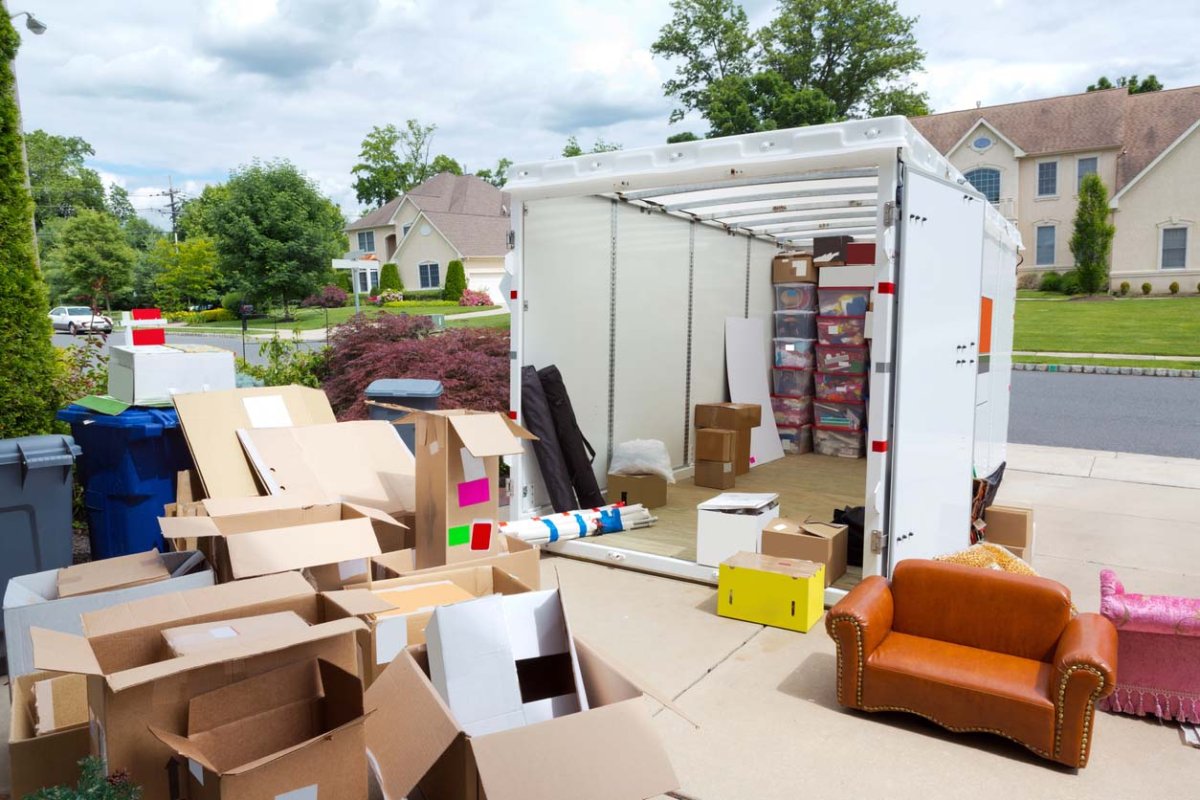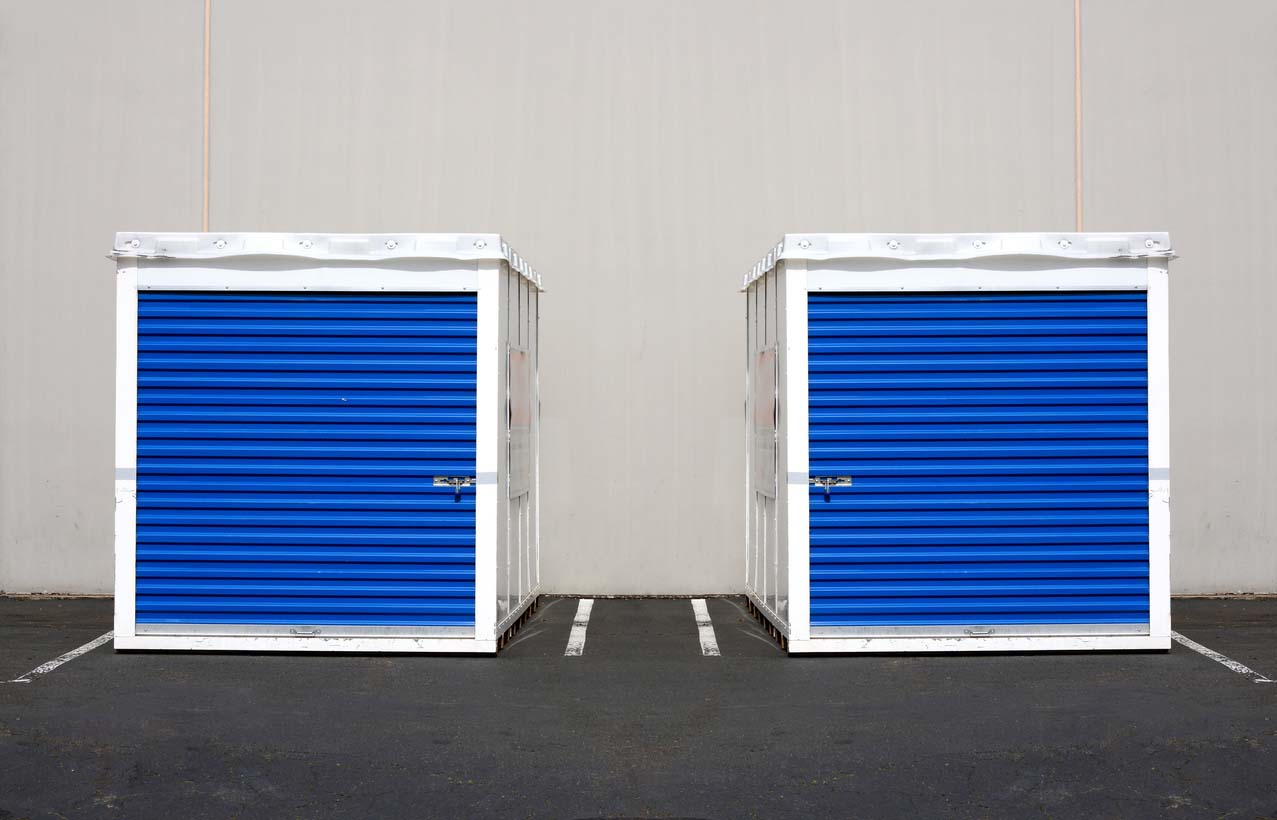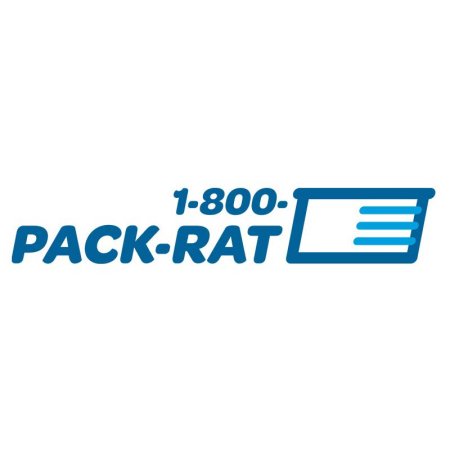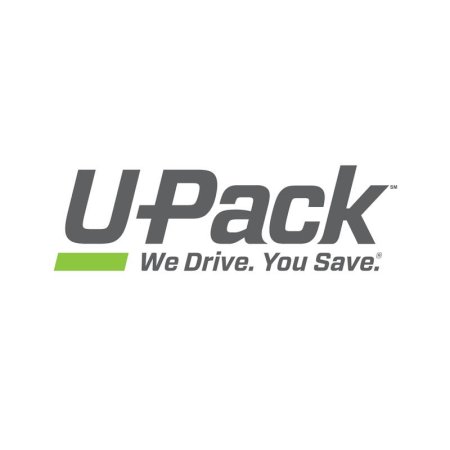
We may earn revenue from the products available on this page and participate in affiliate programs. Learn More ›
While a DIY move that involves renting a moving truck is the most affordable way to move, many people don’t like the idea of driving a large box truck long distances. A moving service offers end-to-end support, from packing to moving to unloading, but it can cost thousands of dollars. Moving container companies offer a happy medium between these two extremes. These services cost much less than a professional moving service but don’t require the customer to drive a moving truck.
Moving container companies will deliver an empty shipping container to a customer’s property, then return days later to move it once it’s been loaded. These containers offer flexibility that DIY or professional moves may not offer. A moving container can immediately be moved to the new home, or it can go into storage for an extended period until the customer is ready to have it delivered. Moving containers are also easy to order, with many moving container companies offering quotes and scheduling online. Read on to find out what to look for when shopping for a moving container, and discover the best moving container companies in the country.
- BEST OVERALL: U-Haul U-Box
- RUNNER-UP: PODS
- BEST FOR STORAGE: 1-800-PACK-RAT
- BEST BANG FOR THE BUCK: Zippy Shell
- ALSO CONSIDER: U-Pack

What to Consider When Choosing One of the Best Moving Container Companies
When choosing the best moving container company, a customer will want to consider many factors, including move distance, container size, and loading and shipping time. Just ahead, learn more about these attributes and what to know about this alternative to using one of the best moving companies for a move.
Service Area and Quote Process
When selecting a moving container company, customers will want to determine where the container will be stored. After the customer has loaded the container, the moving container company will move it to a storage facility until the customer is ready for it to be delivered. If the customer anticipates needing to access the container while it’s in storage, they’ll want to consider a company with a nearby storage facility. Customers can reach out to a company representative to ask about storage facility access availability. Customers will also want to remember that not all moving container companies can serve every corner of the country, so it’ll be essential to find a company that can deliver a container to both the customer’s old and new addresses.
Moving crate companies vary in how they supply quotes for their shipping containers. Almost all moving container companies will allow customers to get a quote for storage services online, but some companies may only provide moving quotes by phone. This is because there are more logistics to consider with moving, and minor differences can significantly alter the quote. However, some companies allow customers to get an online quote for both moving and storage services without speaking to a customer support representative.
Move Distance
The best moving pod companies vary in how they define the difference between local and long-distance moves. It’s important to keep this in mind because some moving container companies have a minimum distance for moving a shipping container from the current home to the new house. For many moving container companies, a local move is under 50 miles, and a long-distance move is more than 50 miles.
Pricing
Rates for container moving services can vary depending on the customer’s location, the move distance, the size of the container they need, and the number of containers rented, among other factors. Moving container companies may also charge a delivery fee for bringing a container to a customer’s home and, in some cases, may assess an additional fee to pick up the container once the move has been completed or the customer no longer needs to store their belongings. Customers who work with container companies for storage will typically pay a monthly rate. For those looking to hire container services to assist with a move, it’s good to remember that prices may fluctuate depending on the time of year and even the day of the week, so those with flexible moving times may be able to reduce their overall moving costs. Customers looking to move on a very tight budget may want to consider one of the best cheap moving services, such as American Van Lines and Budget Truck Rental.
Container Material and Size Options
The best moving containers are made of steel or high-grade plywood with a waterproof covering. Some shipping containers may just be steel cages, and others will have enclosing walls. Each container type has its pros and cons. Full steel containers will be more secure, but there’s less air circulation, which could encourage mold or mildew growth if there is moisture in the container. If a customer feels strongly that one material type is preferable to another, they will want to seek out a moving pod company that offers that type of container.
Customers will want to pay attention to the size options provided by moving companies with storage containers. Some companies offer a range of container sizes, and customers will be able to opt for one large container to fit all their belongings. Other companies only offer one smaller container size, and customers may need multiple containers to hold all their belongings. With that in mind, it’s worthwhile for customers to make an inventory of their belongings ahead of time so they can determine the best storage options for moving.
Loading and Shipping Time
It’s crucial for customers to be aware of the loading and shipping times when they choose the best moving pod company for them. While some companies require their customers to complete loading in just a few days, others allow their customers to keep the shipping container at their home indefinitely (though the customer will still pay for the container). Customers will also want to inquire how long the container takes to arrive at the new home. Knowing this information will help customers plan their move accordingly. Although some companies will provide an estimated delivery time, others will guarantee a delivery date.
Packing and Loading Assistance
One of the downsides of using a moving container is that customers still have to load the container themselves. However, most moving container companies allow customers to hire third-party services to help pack for a move and load the moving container. These services can take some of the burden off the customer, and the entire move will likely be more affordable than it would be if hiring a full-service professional mover.
Storage Availability and Facility Climate Control
Customers will want to consider their moving container options when selecting the best container moving company. All moving container companies will have facilities to store containers for customers who are not moving their belongings immediately. Customers who are storing delicate items, like art or heirlooms, may want to identify a storage facility that’s temperature or climate controlled.
Some storage companies allow customers to store the container on their property for an indefinite amount of time, which is ideal for customers who are using the container to store belongings or supplies during a renovation or remodel.
Insurance
When using one of the best moving pods companies, customers will want to contact their homeowners or renters insurance company to determine whether the insurance will cover their belongings while they’re in storage. If not, the customer will want to consider adding additional coverage to protect these items. Some moving container companies also offer insurance coverage for customer property for an additional monthly fee.
Cancellation Policy
The cancellation policies of moving container companies are all different. While some companies allow cancellation up to the day of delivery, others require as many as 7 days’ notice before the delivery date to avoid fees. Since cancellation fees can be as high as $300, it’s crucial that customers familiarize themselves with a moving container’s cancellation policies before renting.
Our Top Picks
The moving container companies below are widely available throughout the United States, offer transparent pricing, and are capable of conducting both local and long-distance moves. Keep reading to find out more about the best options.
Best Overall
U-Haul U-Box
Pros
- Nationwide availability
- Relatively low monthly storage rates
- Fast, streamlined online quote process
- Comprehensive pricing breakdown
- Guaranteed container arrival date
- No cancellation fees
- No container delivery fees
Cons
- Limited container options
- Plywood containers may not be as secure as steel containers
Specs
- Service area: Nationwide
- Quote process: Online
- Move distance: Local, long distance, international
- Container size options: 8-foot containers
- Loading time: Unlimited
- Cancellation policy: No cancellation fees
Why It Made the Cut: U-Haul U-Box offers competitive rates, nationwide availability, no cancellation or delivery fees, and a streamlined, transparent quote process. One of the best moving truck rental companies is also one of the best when it comes to renting a moving container. U-Haul’s U-Box is affordably priced with relatively low monthly storage rates and a transparent and quick online quote process that lets customers know exactly what they’re paying before they commit. U-Haul also provides guaranteed container delivery dates, giving customers peace of mind that their belongings will arrive when they’re expected. There’s only one U-Box size, and some customers may believe the plywood construction is less secure than steel moving containers. However, U-Haul claims that the U-Box is sturdy, and the durable weatherproof plastic cover keeps belongings safe from the elements. Other standout qualities of U-Haul’s U-Box include other standout qualities include no cancellation or container delivery fees, making the already affordable cost even more attractive. In addition, moving container services are available across the entire country so customers can rent a container for a move or to store their belongings no matter where they live in the U.S. The company even offers moving and storage services for international moves, with full-service, door-to-door options available.
Runner-Up
PODS
Pros
- Wide container size range with options of 8, 12, and 16 feet
- Relatively low 2 percent damage rate
- Flexible content protection plans ranging from $5,000 to $300,000 in value
- Specialized services for city dwellers
Cons
- Relatively high container delivery fee
- Moving and storing services not available in all ZIP codes
Specs
- Service area: 46 states and Washington, D.C.
- Quote process: Online for storage, phone for moving
- Move distance: Local; long distance; international to Canada, United Kingdom, and Australia
- Container size options: 8-foot, 12-foot, and 16-foot containers
- Loading time: Unlimited
- Cancellation policy: Must cancel by 4 p.m. 3 days before container delivery or fees may apply
Why It Made the Cut:
PODS is a popular name in the moving container industry for good reason—the company offers multiple container size options and flexible content protection plans, and it has a low damage rate.
PODS is one of the original moving container companies, and its offerings still make it a great choice. The company has an excellent track record for handling customer belongings with a less than 2 percent damage rate—well below the 20 percent industry average. The company’s flexible protection plans range from $5,000 to $300,000 in value to ensure adequate protection for the customer’s belongings. PODS offers three container size options to suit different-size moves. The company also offers unlimited loading time, and it can handle both local and long-distance moves, as well as international moves to a few select countries. Customers may want to note that moving services may not be available in all ZIP codes within the company’s service area.
PODS prices vary depending on the location, time of year, and container size, among other factors, but delivery fees for PODS containers can be relatively high. With that in mind, it’s a good idea for customers to check all applicable fees before selecting a storage or moving service. The company also offers specialized services for those moving in urban areas. PODS works with city dwellers by procuring all the permits necessary to deliver the container. The PODS driver will then stay with the pod while the customer loads it to protect against thieves and parking enforcement officers.
Best for Storage
1-800-PACK-RAT
Pros
- Wide container size range with options of 8, 12, and 16 feet
- Temperature-controlled storage facilities
- 24/7 surveillance at storage facilities
Cons
- Relatively high monthly storage rates
- Relatively high $500 deposit on long-distance moves
Specs
- Service area: Storage facilities in 34 states; shipping to 97 percent of U.S.
- Quote process: Online for storage, phone for moving
- Move distance: Local, long distance
- Container size options: 8-foot, 12-foot, and 16-foot containers
- Loading time: Unlimited
- Cancellation policy: Must cancel 5 days before container delivery or fees may apply
Why It Made the Cut:
With multiple container size options, temperature-controlled storage facilities, and 24/7 surveillance, 1-800-PACK-RAT is an excellent option for long-term storage as well as moving.
1-800-PACK-RAT offers amenities that may appeal to those who plan to leave their belongings in storage for an extended period. There are three sizes of containers available (8-, 12-, and 16-foot containers) giving customers multiple options to consider depending on how much they have to store or move. While these amenities do make the containers ideal for long-term storage, 1-800-PACK-RAT may have somewhat high monthly storage rates. Those who schedule a long-distance move with the company will also need to make a $500 deposit. However, customers may be able to get better rates for weekday or off-season moves, so 1-800-PACK-RAT is still a great option to consider.
In addition, the company’s storage facilities are temperature controlled, making them suitable for storing items that can be ruined by extreme temperatures. And with its 24/7 surveillance, 1-800-PACK-RAT is also one of the most secure moving container storage companies in the business.
Best Bang for the Buck
Zippy Shell
Pros
- Temperature-controlled storage facilities
- Relatively low monthly rates
- Content protection plans with full replacement value coverage available
Cons
- Cancellation policy not specified
- Metal cage container design not be ideal for some items
- Loading time limited to 3 days
Specs
- Service area: Not specified
- Quote process: Online for storage, phone for moving
- Move distance: Local, long distance
- Container size options: 10-foot and 15-foot containers for moving; 16-foot containers for storage
- Loading time: Up to 3 days
- Cancellation policy: Not specified
Why It Made the Cut:
Zippy Shell offers relatively low rates for its moving containers, as well as temperature-controlled storage facilities for customers to utilize.
Those looking for an affordably priced moving container option may want to consider Zippy Shell. The company boasts relatively low monthly rates to rent its 10- and 15-foot containers, which could be very appealing to those moving on a tight budget. And once loaded, the storage container is shipped to one of Zippy Shell’s temperature-controlled facilities, making it a suitable option for storing items that are sensitive to extreme temperatures.
The company’s website does not provide any information about its cancellation policy, so customers will need to check with the company to see if they may need to pay a fee for canceling services. Customers are also limited to a 3-day loading period, which may necessitate additional planning before the container is delivered. Zippy Shell’s containers have a metal cage design without fully enclosed walls, which some customers might find less secure than fully walled containers. However, Zippy Shell claims that this feature is a positive, as it allows air to circulate and minimizes any potential mold or mildew growth.
Zippy Shell also offers a robust content protection plan for stored belongings that includes replacement value coverage. This means that if covered items stored in a container are damaged or stolen, the company will calculate their value based on the cost to replace those belongings with similar items at current prices. Because this coverage does not factor in depreciation, customers could receive more compensation if any belongings placed into a container are damaged, lost, or stolen.
Also Consider
U-Pack
Pros
- Nationwide availability
- Streamlined, fast online quote process
- Average container transit time of 4 to 6 business days
Cons
- No local moving services
- Rigid cancellation policy
- No option to access container while in storage
- No weekend drop-off availability
Specs
- Service area: Nationwide
- Quote process: Online, phone
- Move distance: Long distance
- Container size options: 7-foot containers; 5-foot to 26-foot moving trailers
- Loading time: Up to 3 business days
- Cancellation policy: No fee for cancellations up to 7 days before container delivery; $50 fee for cancellations within 7 days of delivery; $150 fee for cancellations day of delivery
Why It Made the Cut:
A nationwide footprint, short delivery time frame, and easy online quote process make U-Pack a moving container company worth consideration.
With its simple quote process and fast delivery time, U-Pack is a great option for those using a storage container for a long-distance move. Customers can complete the quote process online, eliminating the need to go through a lengthy over-the-phone quote process. U-Pack also has a relatively short transit time of as little as 4 business days, which is relatively quick for a long-distance move.
It’s worth noting that U-Pack does not offer local moving services, and there are no weekend container drop-offs available. In addition, the company’s cancellation policy can be fairly rigid, with customers being charged a fee depending on how far in advance they cancel. Customers also won’t be able to access their containers once they’re at the storage facility. However, as long as a customer can plan around these factors, U-Pack is an option worth checking out no matter where they live in the U.S. U-Pack services are available in all 50 states and Washington, D.C., so customers across the country can hire the company for their moving needs.
Our Verdict
U-Haul U-Box is our pick for Best Overall thanks to its competitive rates, minimal fees, broad coverage area, and easy quote process. Those looking for more options regarding container sizes or planning an urban move would do well to consider our Runner-Up, PODS, which offers three container size options and a service that caters to city dwellers.
How We Chose the Best Moving Container Companies
We looked at a variety of criteria when vetting our list of the top moving container companies. We considered the size of the company’s service area, leaning toward those with broader national coverage. When comparing 1-800-PACK-RAT versus PODS, for instance, we looked at each company’s footprint to assess service availability. Also a consideration was how much loading time the container company provides its customers and the estimated delivery time for the storage unit to the new location. We also preferred companies that offer their customers a broader range of container sizes. Customers will want to know how much the service will cost up front, so we selected companies with a straightforward quote process and transparent pricing. Other factors we considered included cancellation policies, security, and storage facility amenities.
Before You Use One of the Best Moving Container Companies
Before hiring a moving container company, customers will want to consider alternatives. While the best moving storage containers are more affordable and offer more flexibility than hiring a moving company, customers must load the container themselves. The customer will also need to park the container in a suitable area while loading and unloading. This necessitates having a driveway, reserved parking spot, or another open space where the container can be dropped off and picked up. Homeowners associations may have restrictions on using moving containers, even if the container fits in the resident’s parking space or driveway.
When packing a container, customers will want to take care not to load any damp items that could cause mold growth since the container may remain closed for days, weeks, or even months. They may also want to take steps to prevent infestation when moving. Storage containers could become breeding grounds for pests if boxes are not properly sealed or if customers fail to notice the signs of infestation when packing their belongings. And those who live in gypsy moth or spotted lanternfly quarantine areas and are moving to non-quarantine areas should also take extra care to ensure they don’t end up packing and moving any of these pests in their moving containers. Customers moving out of quarantine areas may have to sign additional forms when scheduling their moving container delivery.
Cost of Using One of the Best Moving Container Companies
Three main factors influence the cost of a moving container: season, distance, and size. Expect to pay between $1,200 and $7,500 for a moving container. For instance, PODS moving costs average around $3,000, but the exact price will depend on how far the move is, what size container a customer selects, and when the move is scheduled. Local moves with smaller containers will be on the low end of that range, while large containers that must travel long distances will be on the upper end. Most storage containers generally cost more to rent on weekends and during the peak moving season, which is between April and September.
Customers may also need to budget for packing services if they plan to hire a third party to take care of that aspect of their move. Boxes and packing materials are additional expenses to consider, and some municipalities may require residents to pay permit fees to place storage containers on public streets. All of these factors are worth weighing when customers are calculating how much it costs to move.
The Advantages of Using One of the Best Moving Container Companies
There are many good reasons to use the best storage pod company. Whereas a standard storage unit requires one to move their belongings to and from the unit, a moving container can move anywhere, minimizing work and eliminating the need to rent a moving truck. Since portable storage containers rest flat on the ground, they’re easier to load than a moving truck elevated off the ground. And provided the customer doesn’t mind loading the container themselves, moving containers offer significant cost savings over a full-service moving company.
- Offers greater portability
- Eliminates the need to rent and drive a moving truck
- Easier packing experience
- More affordable than a moving service
FAQs
If you’re wondering what the cheapest way to move cross-country is or how to determine what size container you need, then keep reading for those answers and more.
Q. What are other companies like PODS?
While PODS is one of the top moving container companies, there are other good moving storage options, too. In addition to moving truck rental, U-Haul also rents moving containers, and it may be worthwhile for customers to directly compare PODS versus U-Haul to see which option makes the most sense for them. Other storage container companies include 1-800-PACK-RAT, Zippy Shell, and U-Pack.
Q. What is the cheapest way to move long-distance?
The most affordable way to move a long distance is to rent a moving truck that you load, drive, and unload yourself. While renting a moving container is more expensive, it’s much more affordable than hiring a moving service and may be a happy medium between DIY and full-service moving. Those weighing their moving container versus truck rental options may also want to consider how comfortable they feel about driving a moving truck across the country. Hiring a shipping container moving service could be much more convenient in that regard and ease the stress of a long-distance move.
Q. Where can I find small moving storage containers?
U-Haul U-Box, PODS, and 1-800-PACK-RAT have small moving container options.
Q. How do you determine what size moving container you’ll need?
The best way to determine what size moving container you need is by looking at the size of the home. An 8-foot container is large enough for a small apartment, while a 16-foot container is typically large enough to handle a 2- or 3-bedroom house. Larger homes may require multiple storage containers.
Q. Are moving containers waterproof, weatherproof, and secure?
Many companies offer weatherproof storage containers; however, you will want to check with the individual storage company to determine how watertight the container is. Customers can also check with the company to determine what security measures it uses to protect customers’ belongings when they are storing containers at one of the company’s storage facilities.
Q. Is there anything you should not put in a moving container?
Certain items should never be stored in a moving container. Most companies prohibit storing hazardous materials such as fertilizer, paints, aerosols, motor oil, and cleaning solvents. You should also never put plants or other living things in a container. Finally, it’s a good idea to avoid storing valuables such as cash, family heirlooms, financial documents, jewelry, and electronics in a moving container.
Sources: Move.org








